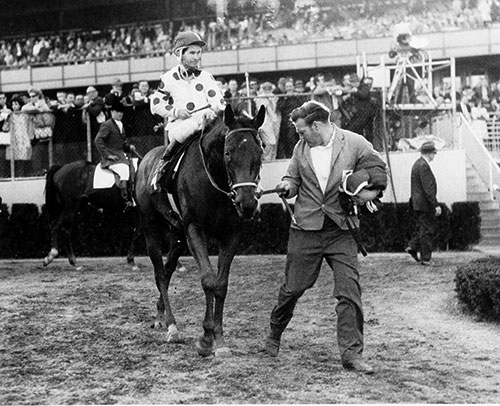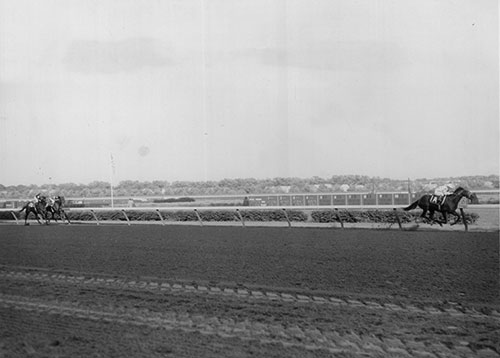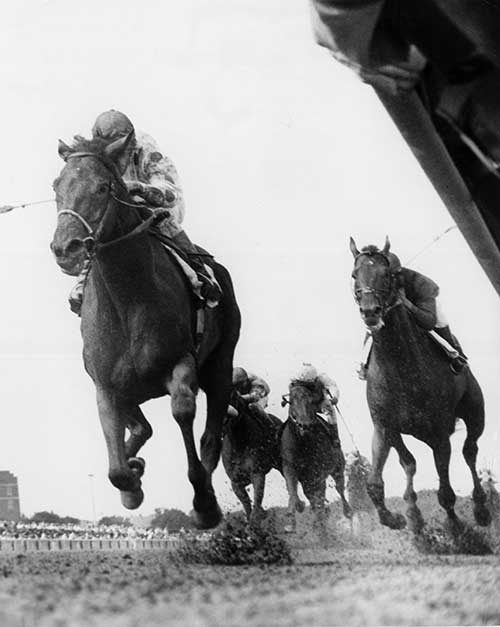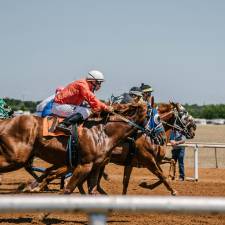
by Bob Ehalt
Rivalries are on the verge of becoming passé these days.
With shorter careers and horses receiving more time off between races, the best horses are squaring off much less frequently than decades ago.
In fact, one of the most heated rivalries since the turn of the century involved Zenyatta and Rachel Alexandra – and they never raced against each other.
The situation was markedly different, of course, 40 or 50 years ago, especially in 1967 and 1968 when Damascus was at the center of battles between three of the best horses of the last 60 years.
Owned by Edith Bancroft and trained by Frank Y. Whiteley Jr., Damascus squared off with Dr. Fager and Buckpasser in a few of that era’s most famous races and he won two of the meetings – which was not unusual for him.
In 32 career starts, Damascus won 21 times and finished second seven times, earning $1,176,781, numbers that justify his induction into the National Museum of Racing and Hall of Fame in Saratoga in 1974.
Damascus’ career started relative late for the 1960s as the homebred did not make his first start at 2 until Sept. 28, 1966, when he finished second in a maiden race at Aqueduct under jockey Bill Shoemaker.
Yet it didn’t take long for him to develop into a stakes winner as he captured the Remsen Stakes to end his 2-year-old campaign and stamp himself as a major threat for the Kentucky Derby.

His first race at 3 produced a victory in the Bay Shore Stakes, but then he ran into a buzz saw named Dr. Fager, who defeated him in the Gotham Stakes as the two horses moved together for the lead with four furlongs left and dueled as a team through the stretch, with Dr. Fager winning by a half-length.
While Dr. Fager missed the spring classics, Damascus went on to win the Wood Memorial and was part of the favored entry in the run for the roses.
Unfortunately, the first Saturday in May was not his day and Damascus could do no better than third behind Proud Clarion in the Kentucky Derby. Yet after that, Damascus quickly returned to top form, winning the Preakness by 2 ¼ lengths and taking the Belmont Stakes by 2 ½ lengths as a 4-5 favorite to vault to the head of the 3-year-old class.
He then won the Leonard Richards at Delaware Park, but suffered a stunning loss by a nose in the Du Pont Handicap, also at Delaware.
That loss was only a temporary glitch as Damascus reeled off four straight wins, including a 22-length wipeout of three rivals in the Travers at Saratoga.
That set the stage for a huge showdown in the mile-and-a-quarter Woodward at Aqueduct with Dr. Fager, who owned six straight wins, and Buckpasser, the champion 3-year-old and Horse of the Year in 1966 who would win 25 of 31 career starts.
Named after Bancroft’s father, Belair Stud owner William Woodward Sr., the Woodward became a part of racing lore for an incredible matchup and some long-discussed tactics.
Fearing Dr. Fager’s early speed, Whiteley decided to make the Tartan Stable star work unusually hard on the front end by entering a stablemate named Hedevar. A sprinter who had equaled the world record time of 1:33 1/5 for a mile a year earlier, Hedevar had little chance of winning at the 10-furlong distance, but he was not entered in hopes of recording an upset victory.
He was there strictly to push Dr. Fager and soften him up for Damascus, though Whiteley insisted before the race that Damascus did not need help.
"Sure, Hedevar is in there to ensure a fast pace," Whiteley told Sports Illustrated. "But, to tell you the truth, there won't be any need for pacesetters if Damascus runs the way I think he can—and think he will."
Yet having to face both Hedevar and Great Power, a “rabbit” for Buckpasser, did not sit well with Dr. Fager’s trainer, John Nerud.
"This won't be a championship race or any kind of a summit meeting," he said in Sports Illustrated, "if they are going to toss in a lot of trash just to run me into the ground."

As soon as the gates opened, the “rabbits” went to work. Hedevar rushed out to the lead from the rail with Dr. Fager outside of him and Great Power three wide as they motored away from the field.
The early fractions told the tale of what was happening as Dr. Fager and Hedevar carved out suicidal fractions of 45 1/5 seconds for a half-mile and 1:09 1/5 for six furlongs in the 10-fulong test.
Great Power dropped back first and early on the final turn Hedevar began to fade from sight. Yet their mission was accomplished. Fatigue caught up with Dr Fager as Damascus rushed past him approaching the quarter pole and opened a widening lead in the stretch.
The son of Sword Dancer went on to win by 10 lengths, in a victory that locked up Horse of the Year honors, while Buckpasser, the betting favorite by a slight margin, grabbed second as Dr. Fager faded to third, 10 ½ lengths behind Damascus, while suffering the worst loss of his Hall of Fame career.
"(Dr. Fager ran) a hell of a three-quarters, in 1:09 1/5 and I knew we were really running,” Bill Boland, who rode Dr. Fager, told Sports Illustrated. “But Hedevar was right with me, and he was making my horse rank.
Great Power wasn't all that far behind, putting the pressure on me too. Both those jocks (Ron Turcotte and Bobby Ussery) were hustling and making a lot of noise, whooping and hollering, and it didn't help me at all. But, what the hell, that's part of this game. We all do it, so I can't complain."
From Shoemaker, there was nothing but immense praise for Damascus.
"This colt gets better all the time, and I'll say it again, though some people don't believe it,” he said in Sports Illustrated. “Damascus is as good a horse as I have ever ridden. That includes the best, such as Swaps, Kelso, Gallant Man, and even Buckpasser himself."
Damascus won the Jockey Club Gold Cup
Before the year ended, Damascus won the Jockey Club Gold Cup, with neither Dr. Fager nor Buckpasser (who was retired after the Woodward) in the field, en route to honors as Horse of the Year, the champion 3-year-old and co-champion handicap horse.
After that, he made the lone turf start of his career, turning in a valiant effort in the Washington D.C. International while losing by a nose to turf champion Fort Marcy.
As the calendar turned to 1968, the year belonged to Dr. Fager, who won seven of eight races and was named Horse of the Year as well as the champion handicap horse, sprinter, and grass runner, making him the only horse to win four titles in a single year.
That lone loss, however, came at the hands of Damascus, once again with some help from Hedevar.
Damascus started 1968 in California, winning the Malibu and San Fernando and losing by a head in the Strub.
After winning an allowance race, he faced Dr. Fager in the mile-and-a-quarter Suburban Handicap on July 4 and was the 133-pound highweight.

Dr. Fager, who carried 132 pounds, was the 4-5 favorite and in a five-horse field he cruised to the lead under Braulio Baeza under fractions of :48 2/5 and 1:11 with Damascus chasing in second.
This time, with quick but not exhausting fractions and no “rabbit” in the field, it was Damascus and jockey Manny Ycaza who challenged Dr. Fager on the backstretch but grew weary from chasing him. As the reigning Horse of the Year faded to third, Dr. Fager won convincingly by two lengths in the stakes record time of 1:59 3/5.
"Any horse that can run the fastest Suburban ever with 132 pounds must be a great horse," Nerud said after the race. "He's the best horse because he doesn't have to have anyone help him run his race."
Sixteen days after the Suburban, and following a third-place finish in the Haskell at Monmouth, Damascus tangled with Dr. Fager again. They squared off in the Brooklyn Handicap, again at a mile-and-a-quarter, only this time Hedevar was among the field of seven.
Much like the Woodward, Hedevar pushed Dr. Fager through fractions of 45 4/5 and 1:09 2/5, once again weakening the 135-pound highweight and 3-5 favorite.
Carrying 130 pounds, Damascus rushed up to join Dr. Fager at the quarter pole and then pulled away in the final furlong to prevail by 2 ½ lengths in the track record time of 1:59 1/5 at Aqueduct.
After that, Damascus and Dr. Fager never met again and Damascus lost his final three starts, finishing second in the Michigan Handicap and Woodward before he suffered a bowed tendon in the Jockey Club Gold Cup that ended his career.
The injury ended a brilliant career that featured one of the sport’s great rivalries which ended in a fitting manner: with two wins each and races that are still widely discussed decades later.
Fun Facts
- Damascus carried 130 pounds or more in six different starts.
- Damascus was the betting favorite in 28 of his 32 starts.
- He won at distances from six furlongs to two miles.
- In 1967, Damascus set the single-season earnings record of $817,941.
- After Damascus was retired, he became a stallion at Claiborne Farm for a syndication price of $2,560,000.
- Daughters of Damascus accounted for more than 160 stakes winners.
This article originally appeared on AmericasBestRacing.net and is published here with permission. Find out more about Thoroughbred Horse Racing on EIE.
Are you interested in promoting your business or sharing content on EIE? Contact us at info@equineinfoexchange.com













